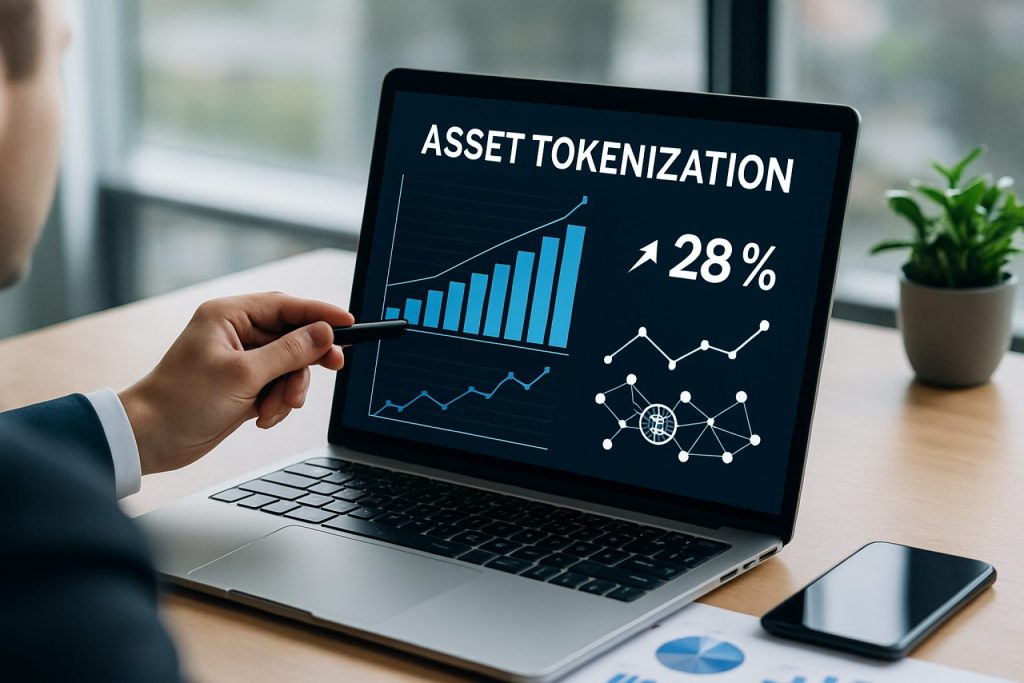
Asset Tokenization Platforms Market Report 2025: In-Depth Analysis of Growth Drivers, Technology Shifts, and Global Opportunities. Explore How Blockchain is Reshaping Asset Ownership and Investment Models.
- Executive Summary & Market Overview
- Key Technology Trends in Asset Tokenization Platforms
- Competitive Landscape and Leading Players
- Market Growth Forecasts (2025–2030): CAGR, Market Size, and Key Segments
- Regional Analysis: North America, Europe, Asia-Pacific, and Emerging Markets
- Future Outlook: Strategic Opportunities and Market Evolution
- Challenges, Risks, and Opportunities in Asset Tokenization
- Sources & References
Executive Summary & Market Overview
Asset tokenization platforms are digital infrastructures that enable the conversion of real-world assets—such as real estate, equities, commodities, and fine art—into blockchain-based tokens. These tokens represent ownership or fractional interests, facilitating more efficient, transparent, and accessible trading and investment. As of 2025, the asset tokenization market is experiencing rapid growth, driven by increasing institutional adoption, regulatory clarity in key jurisdictions, and the maturation of blockchain technology.
According to Boston Consulting Group, the total value of tokenized illiquid assets could reach $16 trillion by 2030, with significant momentum building in 2025 as financial institutions and asset managers accelerate pilot projects and commercial launches. The market is characterized by a diverse ecosystem of platform providers, including established financial technology firms, blockchain-native startups, and major exchanges. Notable players include Tokentus, SIX Digital Exchange (SDX), and tZERO, each offering varying degrees of regulatory compliance, asset coverage, and integration with traditional financial systems.
Key drivers in 2025 include:
- Regulatory Progress: Jurisdictions such as the European Union, Singapore, and the United States have advanced frameworks for digital securities and tokenized assets, reducing legal uncertainty and encouraging institutional participation (European Securities and Markets Authority).
- Institutional Adoption: Major banks and asset managers are launching tokenization initiatives, leveraging platforms to unlock liquidity in private markets and streamline settlement processes (J.P. Morgan).
- Technological Maturity: Enhanced interoperability, scalability, and security features are making platforms more robust and suitable for large-scale deployments (Hyperledger Foundation).
Despite these advances, challenges remain. Interoperability between platforms, standardization of token formats, and cross-border regulatory harmonization are ongoing concerns. Nevertheless, the 2025 outlook for asset tokenization platforms is highly positive, with the sector poised to transform capital markets by democratizing access, reducing costs, and increasing transparency.
Key Technology Trends in Asset Tokenization Platforms
Asset tokenization platforms are rapidly evolving, driven by technological advancements that are reshaping how real-world and digital assets are represented, traded, and managed on blockchain networks. In 2025, several key technology trends are defining the competitive landscape and operational capabilities of these platforms.
- Interoperability and Cross-Chain Functionality: As the tokenization ecosystem expands, platforms are prioritizing interoperability to enable seamless asset transfers across multiple blockchains. Solutions such as cross-chain bridges and standardized token protocols (e.g., ERC-3643, ERC-1400) are being widely adopted, allowing tokenized assets to move between Ethereum, Polygon, Avalanche, and other networks without friction. This trend is crucial for liquidity aggregation and broadening investor access, as highlighted by Deloitte.
- Institutional-Grade Compliance and Identity Management: Regulatory compliance remains a top priority. Platforms are integrating advanced Know Your Customer (KYC), Anti-Money Laundering (AML), and digital identity verification tools directly into their token issuance and trading workflows. Zero-knowledge proofs and privacy-preserving technologies are also being deployed to balance regulatory requirements with user privacy, as noted by PwC.
- Programmable Assets and Smart Contract Automation: The use of sophisticated smart contracts is enabling programmable compliance, automated dividend distributions, and dynamic asset management. This automation reduces operational costs and minimizes human error, while also supporting complex financial instruments such as fractionalized real estate, revenue-sharing agreements, and on-chain fund management, according to Boston Consulting Group (BCG).
- Integration with Traditional Financial Infrastructure: Leading platforms are building APIs and middleware to connect with banks, custodians, and trading venues. This integration is essential for mainstream adoption, enabling seamless fiat on/off ramps, real-time settlement, and compliance with existing financial regulations, as reported by J.P. Morgan.
- Enhanced Security and Custody Solutions: Multi-party computation (MPC), hardware security modules (HSMs), and institutional-grade custody solutions are being implemented to safeguard tokenized assets. These technologies address key concerns around private key management and asset recovery, as emphasized by KPMG.
Collectively, these technology trends are accelerating the maturity of asset tokenization platforms, positioning them as foundational infrastructure for the next generation of digital finance.
Competitive Landscape and Leading Players
The competitive landscape for asset tokenization platforms in 2025 is characterized by rapid innovation, strategic partnerships, and increasing institutional adoption. Asset tokenization—the process of converting real-world assets such as real estate, equities, or commodities into digital tokens on a blockchain—has attracted a diverse array of players, including fintech startups, established financial institutions, and blockchain technology providers.
Leading the market are platforms that offer robust compliance frameworks, interoperability, and scalability. tZERO, a subsidiary of Overstock.com, remains a prominent player, leveraging its regulated alternative trading system (ATS) to facilitate the issuance and secondary trading of security tokens. Securitize has also solidified its position, focusing on end-to-end tokenization solutions and regulatory compliance, and has been approved as a transfer agent by the U.S. Securities and Exchange Commission (SEC).
European platforms such as Tokeny Solutions and Tangany have gained traction by providing white-label tokenization infrastructure and custody services, catering to both institutional and corporate clients. In Asia, HashKey Group and ADDX (formerly iSTOX) are notable for their regulatory licenses and focus on private market assets.
Traditional financial institutions are increasingly entering the space. J.P. Morgan has expanded its Onyx Digital Assets platform, enabling tokenized collateral and repo transactions, while Société Générale has issued tokenized bonds on public blockchains. These moves signal a blurring of lines between fintech disruptors and incumbents, with collaborations and consortia becoming more common.
- Boston Consulting Group projects the tokenized asset market could reach $16 trillion by 2030, intensifying competition among platforms.
- Key differentiators include regulatory compliance, secondary market liquidity, asset coverage, and integration with existing financial infrastructure.
- Emerging players are focusing on niche segments such as tokenized real estate, art, and private equity, while established platforms are broadening their asset classes and geographic reach.
Overall, the asset tokenization platform market in 2025 is dynamic, with leading players distinguished by their regulatory credentials, technology stack, and ability to attract institutional capital. Strategic alliances and regulatory clarity are expected to further shape the competitive landscape in the coming years.
Market Growth Forecasts (2025–2030): CAGR, Market Size, and Key Segments
The asset tokenization platforms market is poised for robust expansion between 2025 and 2030, driven by increasing institutional adoption, regulatory clarity, and the growing demand for fractional ownership of real-world assets. According to projections by MarketsandMarkets, the global asset tokenization market is expected to reach approximately USD 5.6 billion by 2025, with a compound annual growth rate (CAGR) of around 19.5% through 2030. This growth is underpinned by the rising integration of blockchain technology in financial services and the expansion of tokenized asset classes beyond traditional securities.
Key market segments driving this growth include:
- Real Estate Tokenization: Real estate remains the largest and fastest-growing segment, as tokenization enables fractional ownership, increased liquidity, and global investor participation. By 2025, tokenized real estate is projected to account for over 35% of the total asset tokenization market, according to Boston Consulting Group.
- Private Equity and Venture Capital: Tokenization of private equity and venture capital funds is gaining traction, offering enhanced transparency and secondary market trading. This segment is expected to grow at a CAGR exceeding 20% during the forecast period, as reported by PwC.
- Commodities and Art: Tokenization of commodities (such as gold and oil) and art is emerging as a significant segment, providing new investment avenues and democratizing access to traditionally illiquid assets. Growth in this segment is anticipated to accelerate as regulatory frameworks mature and investor confidence increases.
Regionally, North America and Europe are expected to maintain market leadership due to advanced regulatory environments and the presence of major financial institutions. However, Asia-Pacific is projected to witness the highest CAGR, fueled by rapid fintech innovation and supportive government initiatives, as highlighted by Deloitte.
In summary, the asset tokenization platforms market is set for significant growth from 2025 to 2030, with real estate, private equity, and commodities leading the way. The market’s expansion will be shaped by technological advancements, evolving regulations, and increasing investor demand for fractionalized, liquid assets.
Regional Analysis: North America, Europe, Asia-Pacific, and Emerging Markets
The global asset tokenization platforms market is experiencing significant regional differentiation as adoption accelerates across North America, Europe, Asia-Pacific, and emerging markets. Each region demonstrates unique drivers, regulatory environments, and market maturity levels, shaping the competitive landscape and growth trajectory for 2025.
North America remains at the forefront, propelled by robust fintech ecosystems, institutional interest, and progressive regulatory sandboxes. The United States, in particular, benefits from the presence of leading platforms and active engagement from both traditional financial institutions and blockchain-native firms. Regulatory clarity is improving, with the U.S. Securities and Exchange Commission and FINRA providing guidance on digital securities, fostering innovation while ensuring investor protection. Canada is also advancing, with the Ontario Securities Commission supporting pilot projects and tokenized asset offerings.
Europe is characterized by a harmonized regulatory push, notably through the European Union’s Markets in Crypto-Assets (MiCA) regulation, set to be fully implemented by 2025. This framework is expected to catalyze cross-border tokenization initiatives and attract institutional capital. Key financial hubs such as Germany, Switzerland, and France are leading in the issuance of tokenized bonds, real estate, and alternative assets, with support from entities like BaFin and FINMA. The region’s focus on interoperability and compliance is fostering a competitive, yet collaborative, environment for platform providers.
- Asia-Pacific is emerging as a dynamic growth engine, driven by digital innovation and government-led blockchain strategies. Singapore and Hong Kong are establishing themselves as regional leaders, with regulatory bodies such as the Monetary Authority of Singapore and Hong Kong Securities and Futures Commission enabling tokenized securities pilots and sandboxes. Japan and South Korea are also advancing, with increasing institutional participation and partnerships between banks and fintechs.
- Emerging Markets—including the Middle East, Latin America, and Africa—are leveraging asset tokenization to democratize access to capital and unlock illiquid assets. The Abu Dhabi Global Market and Brazilian Securities and Exchange Commission are notable for their proactive regulatory approaches, supporting tokenized real estate and commodities. These regions are expected to see rapid adoption as infrastructure matures and cross-border investment barriers decrease.
In summary, while North America and Europe lead in regulatory clarity and institutional adoption, Asia-Pacific and emerging markets are poised for accelerated growth, making regional dynamics a critical factor in the evolution of asset tokenization platforms in 2025.
Future Outlook: Strategic Opportunities and Market Evolution
The future outlook for asset tokenization platforms in 2025 is shaped by accelerating institutional adoption, regulatory advancements, and the maturation of blockchain infrastructure. As traditional financial institutions increasingly recognize the efficiency and liquidity benefits of tokenized assets, platforms facilitating these processes are poised for significant growth. According to Boston Consulting Group, the tokenization of global illiquid assets could reach a market size of $16 trillion by 2030, with 2025 serving as a pivotal inflection point for mainstream adoption.
Strategic opportunities for platform providers are emerging in several key areas:
- Institutional Partnerships: Collaborations with banks, asset managers, and custodians are expected to intensify. Platforms that offer robust compliance, interoperability, and integration with existing financial systems will be best positioned to capture institutional flows. For example, Onramp Invest and Securitize have already established partnerships with major financial entities to streamline tokenized asset offerings.
- Regulatory Alignment: Jurisdictions such as the EU, Singapore, and the UAE are advancing clear frameworks for digital assets, which will reduce uncertainty and encourage broader participation. Platforms that proactively align with evolving standards—such as those set by ESMA and Monetary Authority of Singapore—will gain a competitive edge.
- Expansion of Asset Classes: Beyond real estate and private equity, tokenization is expected to expand into new domains such as carbon credits, intellectual property, and fine art. This diversification will drive demand for platforms capable of supporting a wide array of asset types and complex compliance requirements.
- Technological Innovation: The integration of advanced smart contracts, interoperability protocols, and scalable blockchain networks will be critical. Platforms investing in these technologies—such as Polymesh and Tokentus—are likely to lead in efficiency and security.
By 2025, the evolution of asset tokenization platforms will be characterized by a shift from experimentation to scaled deployment, with a focus on regulatory compliance, institutional-grade infrastructure, and the broadening of tokenized asset offerings. This trajectory positions the sector for robust growth and transformative impact on global capital markets.
Challenges, Risks, and Opportunities in Asset Tokenization
Asset tokenization platforms are digital infrastructures that enable the creation, management, and exchange of tokenized representations of real-world assets—such as real estate, equities, bonds, or commodities—on blockchain networks. As the market for asset tokenization matures in 2025, these platforms face a complex landscape of challenges, risks, and opportunities that will shape their evolution and adoption.
Challenges and Risks
- Regulatory Uncertainty: One of the most significant hurdles is the lack of harmonized global regulation. Jurisdictions differ in their treatment of digital assets, leading to compliance complexities for platforms operating across borders. For example, the U.S. Securities and Exchange Commission and the European Securities and Markets Authority have issued evolving guidance, but regulatory clarity remains a moving target in 2025.
- Interoperability: Many platforms are built on different blockchain protocols, creating silos that hinder seamless asset transfer and liquidity. Efforts to standardize token formats and enable cross-chain functionality are ongoing, but fragmentation persists, limiting the full potential of tokenized markets (Deloitte).
- Security and Custody: The risk of cyberattacks, smart contract vulnerabilities, and inadequate custody solutions remains a top concern. High-profile breaches and technical failures can erode trust and slow institutional adoption (Chainalysis).
- Market Liquidity: While tokenization promises increased liquidity, many platforms struggle to attract sufficient buyers and sellers, especially for niche or illiquid assets. This can result in wide bid-ask spreads and price volatility (Boston Consulting Group).
Opportunities
- Fractional Ownership: Platforms can unlock new investor segments by enabling fractional ownership of high-value assets, democratizing access and broadening participation (PwC).
- Efficiency Gains: Automation of settlement, compliance, and reporting processes through smart contracts can reduce operational costs and increase transparency for both issuers and investors.
- New Asset Classes: Tokenization platforms are expanding into previously illiquid or hard-to-access markets, such as private equity, art, and infrastructure, creating new revenue streams and investment opportunities (McKinsey & Company).
- Institutional Adoption: As regulatory frameworks mature and technology improves, institutional players are increasingly exploring partnerships and pilot projects with tokenization platforms, signaling a shift toward mainstream acceptance.
Sources & References
- Tokentus
- SIX Digital Exchange (SDX)
- tZERO
- European Securities and Markets Authority
- J.P. Morgan
- Hyperledger Foundation
- Deloitte
- PwC
- KPMG
- Securitize
- Tangany
- HashKey Group
- ADDX
- Société Générale
- MarketsandMarkets
- Deloitte
- FINRA
- Ontario Securities Commission
- European Union’s
- Monetary Authority of Singapore
- Hong Kong Securities and Futures Commission
- Abu Dhabi Global Market
- Brazilian Securities and Exchange Commission
- Onramp Invest
- Chainalysis
- McKinsey & Company



